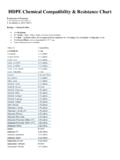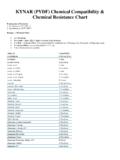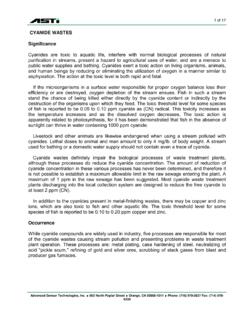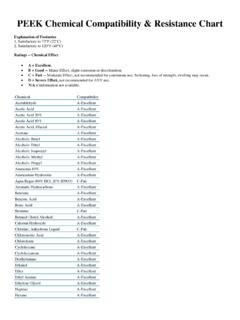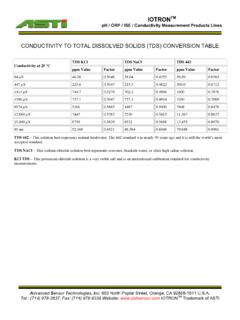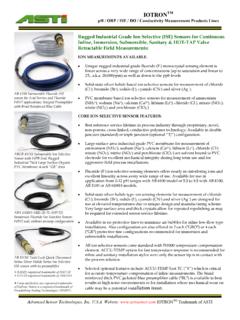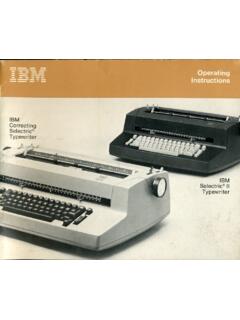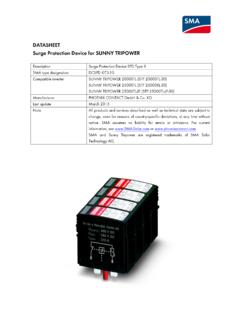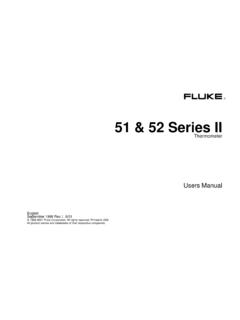Transcription of Minimizing User Errors pH - Advanced Sensor …
1 IMINIMIZING user ERRORSIN pH MEASUREMENTSF eatures, Limitations & Potential Errorsof the Tools of pH MeasurementsAdvanced Sensor Technologies, North Poplar Street Orange CA 92868-1011 USAG eneral inquiries e-mail: Inside Sales e-mail: Site: of Contents1. pH pH Alkaline Acidic Linearity Temperature Solubility of pH Chemical Resistance of pH Electrical Resistance of pH glasses2. Reference Reference Calomel Reference Silver/Silver Chloride Reference Junction Flowing Reference Diffusion Renewable Diffusion Solid State Reference Junctions3. Buffer Temperature Coefficient on the Buffer Interaction of Buffers with pH and Reference Electrodes4. Electronic pH Temperature Sensors5. Practical Mono Combination Symmetric Interpolation vs. Automatic Temperature Compensation6. Matrix to Select pH Equipment for Preset Accuracy & Within +/- Within +/- Within +/- pH11.
2 PH pH RangeOver one hundred different compositions available from many different manufacturersNone exhibit completely linear pH response in overall pH range specifiedMaximum available pH range: -2 to 16 pH in aqueous solutionsOptimum, linear pH range: typically 2 pH units less specified minimum and Alkaline errorpH glass composition, alkali ion and ion concentration dependent at a given pH valueAlways will reduce the pH value measured from the actualError may be as little as pH and up to pH within specified pH electrode measuring rangeVerify alkaline Errors before pH measurement if value expected within 2 pH unit of specified upper limitDetermine alkaline error experimentally before performing measurement if information not Acidic errorMost pH electrodes exhibit a lower than actual pH value in concentrated acidsSome deviation may start at 0. 1 Molar is different for almost every acidError may be as high as pHThere is no clear theoretical explanation and no clear relationship to pH glass compositionsMagnitude of error can be determined by using solutions of known Linearity errorThere is some deviation from a linear pH response even in the range where neither alkaline no acidic error isexhibitedError may be different for every pH glass compositionThe simple compositions show most linearityMaximum for such an error may be about pH but could compound with other potential errorsDepends to a lesser degree on the buffer solutions Temperature RangeMost pH electrodes will work within -5 to 105 CThe general limiting factor is the reference electrodeShort term usage may exceed specified continuous temperature limit by 20 CFor use in non aqueous solutions and under pressurized conditions limit may go up to 150 Solubility of pH GlassespH glasses in reality are only mixtures of oxides.
3 Transparent but otherwise do not exhibit all characteristic ofreal glassesMany are soluble in low conductivity solutions especially in distilled, deionized and ultrapure waterContinuous drift, frequent calibration and short service life will result from pH glass dissolutionThe dissolving process will accelerate at elevated temperatureThere are no data available for selecting the right electrode, trial and error will provide the Chemical resistance of pH GlassesTwo major group of chemical are risk factors, fluorides and carbonatesHydrofluoric acid and bifluorides form precipitates with most pH glasses. Precipitate is porous and will build up over timeAn attacked electrode will develop a slow response, the magnitude of change depending upon thickness of precipitatePrecipitate will adsorb on its large surface sample or buffer causing calibration Errors and requiring repeated may be in the tenth of pH unitsPrecipitate may be removed with concentrated Hydrochloric acid.
4 Electrode will have drastically shortened lifetimeThere are some glass compositions not building precipitate which, after initial exposure do not need recalibration and havereasonable service lifeCarbonates and bicarbonates will slowly react with oxides on the surface of the pH glass. These slightly soluble carbonateswill be dissolved causing drift if exclusively used in such solutions (NIST traceable pH 10 buffer)Limited time exposure to bifluoride and/or bicarbonate solutions may be utilized to rejuvenate contaminated surface of Electrical resistance of pH GlassesElectrical resistance of pH electrodes has no limit in developing electrode potentialElectrical resistance will influence speed of response and accuracy related to instrumentation (refer to sections following)Electrical resistance sharply changes with temperature, will double with approx. every C decrease of temperature, andwill be cut in half with increase of temperatureSpecial glasses are available for extremely low, and extremely high temperaturesLow temperature pH glasses may not function well and may have a limited lifetime above room temperatureHigh temperature glasses exhibit very high resistance at room temperature, which rapidly changes by aging.
5 This will furtherincrease the resistance at room temperature, making calibration difficult and creating potential error in conjunction withinstrumentationElectrical resistance changes with the aging of the electrode and closely resembles an exponential curvepH electrodes with wall thickness above " change resistance at a lower rate than electrode with much thinner walls "32. Reference Reference PotentialReference electrodes typically are electrodes of the second kind, their potential depends on the anion concentration of theirfilling reference electrodes would produce a reference potential independent of temperature, pressure, composition of sampleand have no junction ideal reference electrode does not exist, the design and its selection is always a compromise to achieve maximumaccuracy and reproducibility in a particular Calomel Reference ElectrodeOnce the most widely used reference low temperature Potassium Chloride generates low junction mercury is not welcomed in many convenient to build into combination pH operational temperature limit is about 60 flowing junctions, does not create a proper maintenance.
6 Produces stable and reproducible reference potential for many Silver/Silver Chloride Reference ElectrodeReference potential dependent of fabrication of half high temperature higher the chloride concentration, the higher the temperature higher the chloride ion concentration, the lower the junction Chloride has high solubility in Potassium Chloride in a complex form resulting in potentially high hysteresis at highchloride ion high complex concentration may result in precipitation of Silver Chloride in flowing single junction reference electrodesif the Chloride ion concentration of sample is much lower than that of the filling solution. Silver Chloride will react withmany biological solution. The prevention is to use double junction reference be easily accommodated in combination pH electrodes of any sensitive to. Junction PotentialsThe junction potential is the source of the most hidden error in pH measurements.
7 It develops in the reference junctionseparating the internal filling solution of the reference electrode from the buffer or sample solutions. The cause of thedevelopment is the different diffusion rate of cations and anions on both sides of the reference is difficult to detect, difficult to measure, depends on the kind of reference electrode used, the type of junction employedand the composition and concentration of the buffer or sample resulting error may be as high as system least likely to develop junction potential is when low concentration buffers and sample solutions are measuredand a saturated Potassium Chloride filling solution is than or much lower than theoretical slope should be a warning sign for junction Flowing Reference JunctionsThe most advantages type in generating the lowest junction potential. High velocity, low flow rate is the key of theelimination of junction junction materials are a bundle of quartz fibers, collimated holes, single crystals of asbestos working principal of the junction is to keep ions from the outside to diffuse into the Diffusion JunctionsThe most widely used type of junction.
8 This type includes junction materials of wide diversity from porous ceramics andplastics to porous wood. They may be combined with viscosity reducing agents in the filling solution like CIVIC, agar-agar,natural and synthetic gums, water soluble polymers will always be a junction potential developed on the surface of the junction, which will enter the interior of the fillingsolution creating multiple layers of junction in time of exposure to buffer or sample solution will help to reduce the junction potentials may reach an equilibrium if the reference electrode is exposed to a solution of constant composition andconcentration for prolonged time. Change of either composition or concentration will require significant time to establishnew equilibrium after a long term Renewable diffusion junctionsThis type is a more advantageous type of diffusion junction. All utilize a design where the internal filling solution isin direct contact with the buffer or sample solutions.
9 When solution is changed, the portion of the filling solution incontact with the solution will be discarded and a new portion of the filling solution will be in contact with design does not eliminate the junction potential, but makes it very junctions typically utilize tapered ground glass junctions or single large size capillaries. The renewal of thecontacting filling solution either happens by gravity when separating the two sides the ground glass junction or bytemporarily pressurizing the chamber of the reference electrode filling type of reference junctions need significant maintenance to keep the junction area contamination free. Theyalso need frequent refilling of the filling Solid state reference junctionsMost of them are considered diffusion junctions. The solid state part is typically a crosslinked solid plastic with highconcentration of solid Potassium Chloride and a potential reservoir for solid crystalline diffusion process creating the junction potential is made almost impossible.
10 The dissolution of the solid salt will slowlyexhaust the conducting ions in the solid matrix and stop the function of the reference electrode. They are mainly used indifficult process control Buffer SolutionsThere are many different types of buffer solutions covering the whole pH range and designed for diversified applications. The primaryfunction of these solutions is to provide a known pH value for calibration purposes and preserve this value for a long period of StabilityThe chemical composition of the buffers is selected of highly stable compounds. There are many different exposures in usingthem, which tend to reduce the stability of the buffer of acidic or alkaline media will slowly change the pH value. The amount of acid or alkali to change the pHvalue of a buffer by pH is referred to as buffer use of the buffer will exhaust this capacity and cause an error in of the buffer with deionized of distilled water will also change the pH value of the solution.
